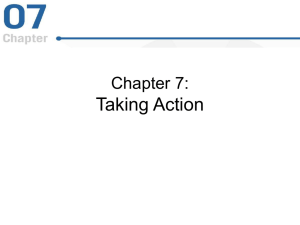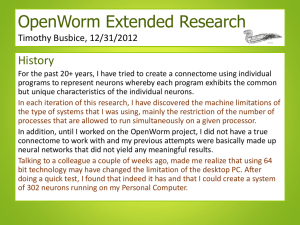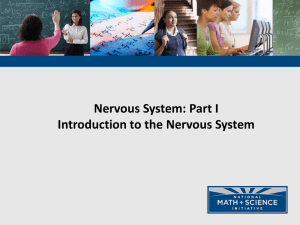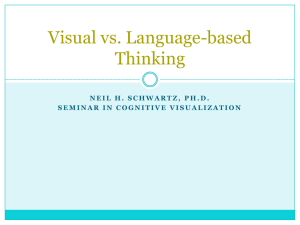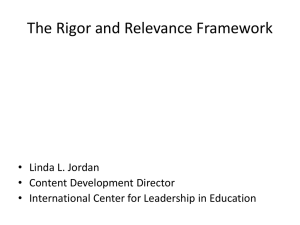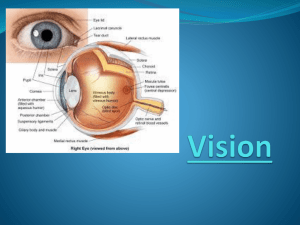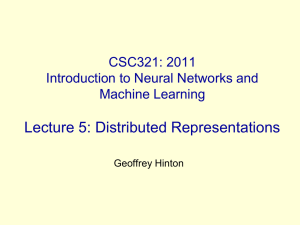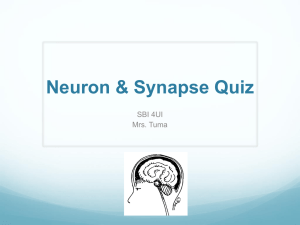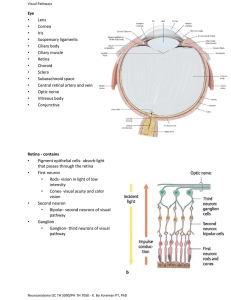Ch 7 Perception and Action
advertisement
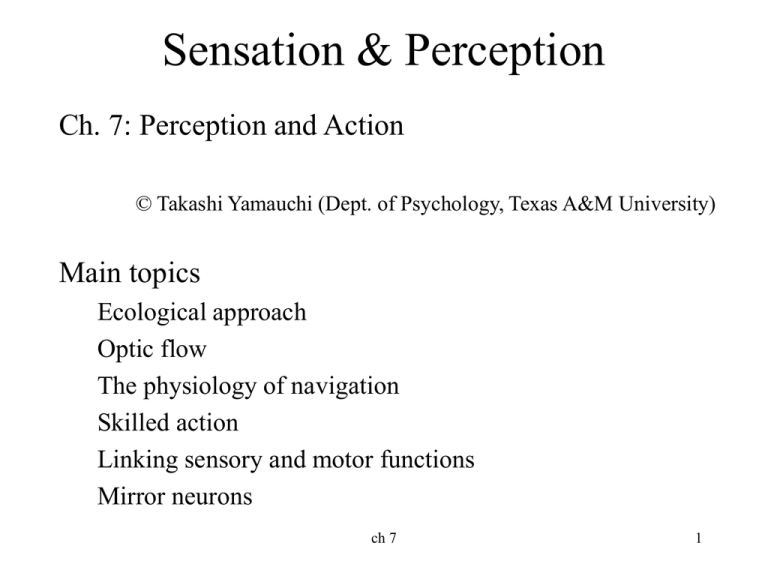
Sensation & Perception Ch. 7: Perception and Action © Takashi Yamauchi (Dept. of Psychology, Texas A&M University) Main topics Ecological approach Optic flow The physiology of navigation Skilled action Linking sensory and motor functions Mirror neurons ch 7 1 Best Action film clip • Just in case, if you were not part of the history – http://www.youtube.com/watch?v=ijXJRcAmI mk&feature=related ch 7 2 Perceptual theories • Many perceptual theories are about integrating top-down and bottom-up processes – Helmholtz’s unconscious inference – Likelihood principle Inverse projection problem Bottom-up information is not enough to create 3D perception. Perception reconsidered • J. J. Gibson’s ecological approach – All the studies we have seen so far are conducted in laboratory settings, in which stationary stimuli were given. – Perception is not a stationary experience. – Perception should be studied as it occurs in the natural environment. ch 7 5 Perceptual experiments • Muller Lyer Illusion • Attention blink • Visual search Question: • What information do perceivers use as they move through the environment? • One type of information is: – Optic flow • E.g., expansion/contraction of a scene (an optic array that reaches the retina). – We notice the ratio of expansion/contraction (a gradient of flow). ch 7 7 Optic flow and a gradient of flow • A gradient of flow gives a strong cue for motion and depth perception. – How much the scene expands on your retina gives you enough information to capture depth perception ch 7 8 Demonstration: http://www.reading.ac.uk/arl/clips/demo_of_displays.htm#opt icflow http://www.youtube.com/watch?v=ysGM3CfBVpU&feature= related ch 7 9 Some important characteristics of optic flow • Invariant information – Gradient information remains constant under different conditions. – E.g., texture gradient ch 7 10 Optic flow helps keep your balance • Demonstration: – Stand up and raise one foot, and stay balanced while your eyes closed. – Isn’t it difficult? ch 7 11 Flow, Posture, and Balance • Experiment by Lee and Aronson – 13- to 16-month-old children placed in “swinging room” • In the room, the floor was stationary but the walls and ceiling swung backward and forward • The movement creates optic flow patterns – Children swayed forward in response to the flow patterns created in the room ch 7 12 The Physiology of Navigation • Optic flow neurons - neurons in the medial superior temporal area (MST) of monkeys respond to flow patterns ch 7 13 Neuron 1 in the monkey’s MST responds to an expanding stimulus but not a stimulus with circular movement. Neuron 2 responds to 14 ch 7 circular movement but not to expansion. Skilled Actions • Skilled actions partly arise from establishing a coordination between sensory and motor systems. • E.g., Somersaulting – Bardy and Laurent found that expert gymnasts performed worse with their eyes closed • They use vision to correct their trajectory • Novice gymnasts do not show this effect ch 7 15 Physiological Links Between Sensory and Motor Functions • Optic ataxia – Patients suffering from this syndrome produce inaccurate reaching movements towards a target or object in space. ch 7 16 • Optic ataxia (3 min) • http://www.youtube.com/watch?v=BkOb9F R5Lgk ch 7 17 Experiment by Schindler et al. • Participants:2 groups • Patients with parietal lobe damage and normal control participants. • Participants performed two tasks • Bisection task - point to position between cylinders • Reaching task - reach between cylinders and touch a gray strip Bisection task In each trial, you saw two cylinders that were shifted different positions. You had to point a place exactly midway between the cylinders. ch 7 18 Experiment by Schindler et al. Trial 1 Bisection task In each trial, you saw two cylinders that were shifted different positions. point You had to point to a place exactly midway between the cylinders. Trial 2 So, for each trial, you had to point different positions. point ch 7 19 Experiment by Schindler et al. Trial 1 Reaching task touch In each trial, you saw two cylinders that were shifted different positions. You had to touch a gray strip that were 20 cm behind the cylinders. Trial 2 touch So, for each trial, you had to extend your hand to different positions. ch 7 20 Results Trial 1 • Bisection task – The patients with parietal lobe damage and normal control were equally accurate touch • Reaching task Trial 2 – The patients kept reaching the same place even though cylinders were shifted in each trial. touch ch 7 21 Interpretation • The parietal lobe provides guidance for movement. • This mechanism operates unconsciously. • But the patients with optic ataxia lost this ability. ch 7 22 Visual dominant vs. motor dominant neurons ch 7 23 Mirror neurons ch 7 24 Mirror neurons • Mirror neurons respond to a particular “kind” of action (e.g., grasping) AND observing someone doing the action. The activity of a particular neuron in the premotor area of a monkey. ch 7 25 The activity of a particular neuron in the premotor area of a monkey. (a) This neuron responded when the monkey watched the experimenter grasp the peanut. (b) This neuron also responded when the monkey actually grasped the peanut. (c) This neuron did not respond when the monkey watched the experimenter pick up the peanut with a pair of pliers.. ch 7 26 Mirror neurons • Respond not only when you are doing a particular action. • But also when you watch someone doing it. • This neuron gives you a general characteristic of an action. ch 7 27 What are mirror neurons for? • Facilitate learning by imitation. – Language development – Skill learning • Social interaction – Empathy (understanding others or what others think) – Connecting with others • Autism may be caused by the deficiency in mirror neurons ch 7 28 • Video clip from NOVA (PBS) – 15 min – http://www.pbs.org/wgbh/nova/sciencenow/320 4/01.html ch 7 29 Creating action by activating motor cortex • motor cortex and motion: brain-machine interface (4:30) – Cathy Hutchinson has been unable to move her own arms or legs for 15 years. But using the most advanced brainmachine interface ever developed, she can steer a robotic arm towards a bottle, pick it up, and drink her morning – http://www.youtube.com/watch?v=ogBX18maUiM&fe ature=youtu.be • ch 7 30
